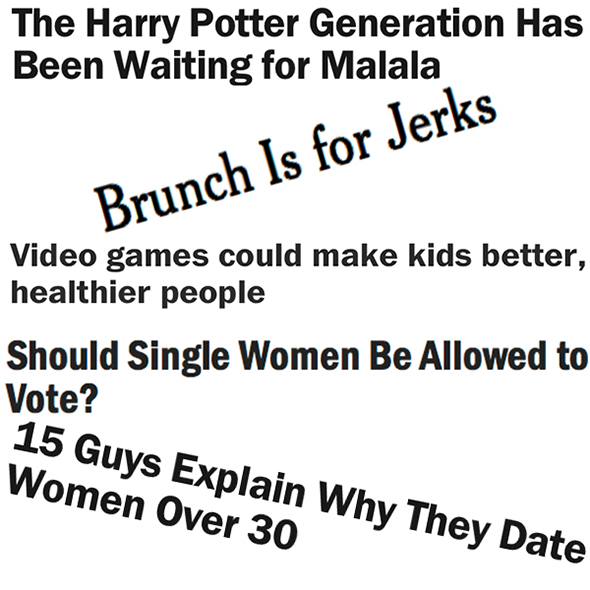
The newest trend in headlines is flat-out trolling readers.
For awhile, the “curiosity gap” was the headline style of choice, meant to entice readers into clicking by omitting a key piece of information. But fewer people are falling for those Upworthy-style headlines. And, though social media referrals remain the most important traffic driver of online content (R.I.P. SEO-bait like “What time is the Super Bowl”), “engagement” is the forward-looking buzzword.
When sites talk about engagement, it tends to mean the amount of time readers spend interacting with content–viral trendsetter Upworthy’s metric of choice is called attention minutes. But in the competition to draw traffic from social media sites like Facebook and Twitter, it doesn’t actually matter what the piece beneath the headline says.
Only a small percentage of people read the stories they are sharing. But the more something is shared, the more people will see it, the more will click. As long as it doesn’t completely destroy brand credibility, hate-sharing–when someone broadcasts an enraging link to followers–is just as valuable for a site as sincere, thoughtful interplay with its work.
Which means that “15 Guys Explain Why They Date Women Over 30,” a Time story from earlier this month, is the perfect piece for this moment’s digital media ecosystem. As is Wednesday’s “Should Single Women Be Allowed to Vote?” on Talking Points Memo. The headlines are infuriating enough that people will pass them along, write aggregated “takes” about their fury, and maybe even settle in for an afternoon hate-read at the original URL. Whether the stories’ content actually reflects their headlines is largely inconsequential (TPM’s doesn’t).
The hate-share headline is a devious twist on the time-honored “#slatepitch,” an idea that sounds wrong or counterintuitive proposed as though it were the tightest logic ever. Readers want to click on Slate Pitches because they want to know what a writer could possibly say that would support their logic (the original Slate Pitch, according to Slate, was “Creed is Good,” from 2009). A hate-share headline also depends on incredulity, but the type that elicits a “tell my why I shouldn’t kick you” as opposed to a “tell my why I should believe you” reaction.
Another recent examples of hate-share headlines include “Brunch Is for Jerks,” a New York Times headline that led my co-worker Greg Marx to tweet:
"Brunch is for Jerks," declares @NYTimes, which trolls its core readership like no other publication http://t.co/wKerlr8UMl
— greg marx (@gregamarx) October 10, 2014
According to Muck Rack’s “Who shared my link” tool, the piece was shared nearly 60,000 times, including by 269 journalists. That means exponentially more people saw it–and the savviest cool-kids probably subtweeted it, which entails followers that understand the referent and, further, the decision to deny them the chance to click on it. (The TPM story, which hasn’t been online as long, has more than 600 social shares; the Time story’s shares topped 1,700.) This was more Slate Pitchy, but another headline in the genre that caught my eye was “Video games could make kids better, healthier people” (Washington Post, 150ish shares) and “The Harry Potter Generation Has Been Waiting For Malala,” again from Time, which seems to be emerging as a master of the hate-share headline genre (8,600-plus shares).
Drawing emotional audiences responses is nothing new; it’s a pillar of the advertising industry. The curiosity gap did it too, in a more benign way. But this deliberate trolling–this very calculated decision to offend, anger, or appall publications’ target readership–may increase reach, but it also draws focus and discussion away from the actual content of a piece. That’s a game outlets can play, but only for so long.
Kira Goldenberg was an associate editor at CJR from 2012-2015. Follow her on Twitter at @kiragoldenberg.
